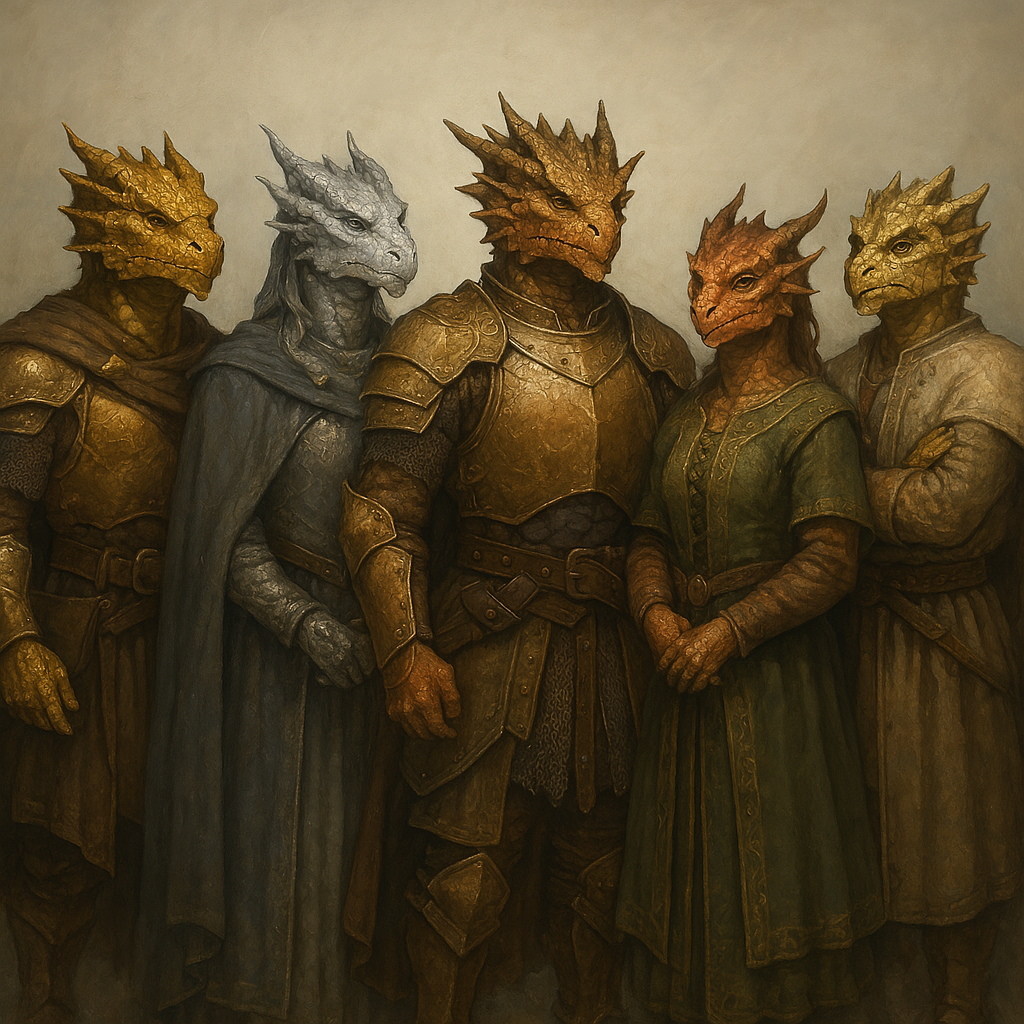Metallic Dragonborn
From the vantage point of anthropological scholarship, the culture and identity of the Metallic Dragonborn constitute a unique and richly layered ethnocultural paradigm, defined not merely by their biological descent from metallic dragons, but by a carefully cultivated social framework rooted in moral philosophy, collective memory, and cultural continuity. These beings, often adorned with resplendent scales of gold, silver, bronze, copper, or brass, occupy a socio-mythical stratum within Eothean civilization, wherein their presence is not only physical but ideologically symbolic.
The Metallic Dragonborn are bound together by a profound ethos that exalts honor, duty, and communal cohesion. These are not abstract values but living tenets, consistently manifested in their customs, institutional frameworks, and kinship systems. Within the anthropological context, their social structure is characteristically gerontocratic and clan-based, with authority conferred through accumulated wisdom, ceremonial standing, and demonstrable service to the collective. This renders their political organization both hierarchical and consultative, where elders and leaders—often artisans, warriors, or spiritual guides—serve as mediators of tradition and arbiters of justice.
Culturally, the Metallic Dragonborn exhibit a synthesis of martial pragmatism and aesthetic sophistication. Their architectural endeavors are emblematic of permanence and metaphysical reverence—structures are designed not solely for defense but also to embody the sacred geometry of draconic lineage. Artistic expressions, whether in the form of sculpture, metalwork, or ceremonial attire, reflect a confluence of cosmic symbolism and clan identity. They are artisans of exceptional repute, and their material culture—especially in metallurgy and enchantment—serves not only utilitarian purposes but reinforces sociocultural narratives of ancestral greatness and divine favor.
The culinary practices of the Metallic Dragonborn further underscore their holistic integration of identity, tradition, and material resourcefulness. Their cuisine privileges quality, balance, and symbolism, often incorporating regional fauna and flora prepared through techniques that preserve natural essence while reflecting the ethos of restraint and refinement. Communal feasting operates not merely as sustenance but as an act of ritualized cohesion, a reaffirmation of shared values, and an opportunity for the performative transmission of oral history.
Ritual practice among the Metallic Dragonborn reveals a deep investment in liminality—the cultural recognition and management of transitional states such as birth, adulthood, union, and death. These rites are not monolithic; they vary according to lineage, geography, and local custom, yet they universally reinforce collective identity and cosmological alignment with the draconic progenitors. Initiation ceremonies, for instance, employ symbolic trials and public recognition to transition individuals into full societal membership, often accompanied by feasts, sacred oaths, and mentorship. Similarly, funerary practices reflect a cosmology that views death not as cessation but as transformation—a return to the ancestral current and the draconic continuum.
Gender dynamics within Metallic Dragonborn society are particularly compelling in their flexibility and relative parity. While there exists a cultural memory of role differentiation—likely vestigial from their martial origins—contemporary observations reveal a broad acceptance of gender pluralism and functional complementarity. Sociocultural roles are increasingly determined by aptitude, interest, and merit rather than prescriptive gender archetypes, signaling an evolving ethic of personal autonomy tempered by communal responsibility.
Courtship and relational ethics are likewise emblematic of the Metallic Dragonborn's valorization of mutual respect and intention. Marital unions are predicated on compatibility not only of affection but of ethos. Courtship rituals often involve exchanges of crafted tokens, shared acts of service, and ceremonial observances that signal both emotional sincerity and social endorsement. Partnerships are conceived not merely as private bonds but as microcosmic representations of inter-clan harmony and continuity.
In conclusion, the Metallic Dragonborn exemplify a cultural complex that harmonizes draconic mythopoetics with lived social realities. Their society is not a static inheritance but a dynamic interplay of heritage, adaptation, and moral intentionality. From an anthropological perspective, they are a culture of living archetypes—simultaneously the bearers of ancient legacies and architects of emergent identities within the diverse civilizational mosaic of Eothea.



Comments